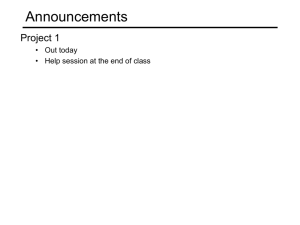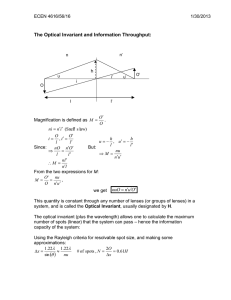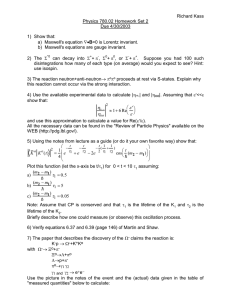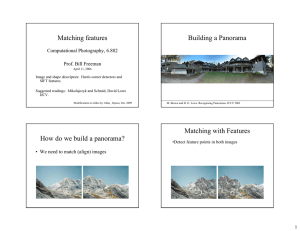CS4670/5670: Computer Vision Lecture 7: Features Part 2 Noah Snavely
advertisement
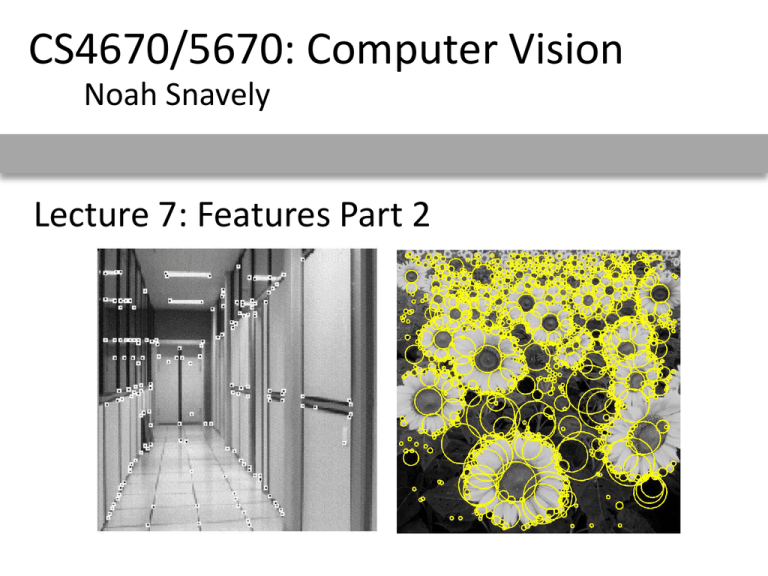
CS4670/5670: Computer Vision Noah Snavely Lecture 7: Features Part 2 Reading • Szeliski: 4.1 Harris Detector: Invariance Properties • Rotation Ellipse rotates but its shape (i.e. eigenvalues) remains the same Corner response is invariant to image rotation Harris Detector: Invariance Properties • Affine intensity change: I aI + b Only derivatives are used => invariance to intensity shift I I + b Intensity scale: I a I R R threshold x (image coordinate) x (image coordinate) Partially invariant to affine intensity change Harris Detector: Invariance Properties • Scaling Corner All points will be classified as edges Not invariant to scaling Scale invariant detection Suppose you’re looking for corners Key idea: find scale that gives local maximum of f – in both position and scale – One definition of f: the Harris operator Lindeberg et al,et 1996 Lindeberg al., 1996 Slide Slidefrom fromTinne TinneTuytelaars Tuytelaars Implementation • Instead of computing f for larger and larger windows, we can implement using a fixed window size with a Gaussian pyramid (sometimes need to create inbetween levels, e.g. a ¾-size image) Another common definition of f • The Laplacian of Gaussian (LoG) g g 2 g 2 2 x y 2 2 (very similar to a Difference of Gaussians (DoG) – i.e. a Gaussian minus a slightly smaller Gaussian) Laplacian of Gaussian • “Blob” detector minima * = maximum • Find maxima and minima of LoG operator in space and scale Scale selection • At what scale does the Laplacian achieve a maximum response for a binary circle of radius r? r image Laplacian Characteristic scale • We define the characteristic scale as the scale that produces peak of Laplacian response characteristic scale T. Lindeberg (1998). "Feature detection with automatic scale selection." International Journal of Computer Vision 30 (2): pp 77--116. Scale-space blob detector: Example Scale-space blob detector: Example Scale-space blob detector: Example Questions? Feature descriptors We know how to detect good points Next question: How to match them? ? Answer: Come up with a descriptor for each point, find similar descriptors between the two images Feature descriptors We know how to detect good points Next question: How to match them? ? Lots of possibilities (this is a popular research area) – Simple option: match square windows around the point – State of the art approach: SIFT • David Lowe, UBC http://www.cs.ubc.ca/~lowe/keypoints/ Invariance vs. discriminability • Invariance: – Descriptor shouldn’t change even if image is transformed • Discriminability: – Descriptor should be highly unique for each point Invariance • Most feature descriptors are designed to be invariant to – Translation, 2D rotation, scale • They can usually also handle – Limited 3D rotations (SIFT works up to about 60 degrees) – Limited affine transformations (some are fully affine invariant) – Limited illumination/contrast changes How to achieve invariance Need both of the following: 1. Make sure your detector is invariant 2. Design an invariant feature descriptor – Simplest descriptor: a single 0 • What’s this invariant to? – Next simplest descriptor: a square window of pixels • What’s this invariant to? – Let’s look at some better approaches… Rotation invariance for feature descriptors • Find dominant orientation of the image patch – This could be computed in several ways: • xmax, the eigenvector of H corresponding to max (what could go wrong?) • Smoothed gradient direction at the center point – Rotate the patch according to this angle Figure by Matthew Brown Multiscale Oriented PatcheS descriptor Take 40x40 square window around detected feature – Scale to 1/5 size (using prefiltering) – Rotate to horizontal – Sample 8x8 square window centered at feature – Intensity normalize the window by subtracting the mean, dividing by the standard deviation in the window 8 pixels CSE 576: Computer Vision Adapted from slide by Matthew Brown Detections at multiple scales Scale Invariant Feature Transform Basic idea: • • • • Take 16x16 square window around detected feature Compute edge orientation (angle of the gradient - 90) for each pixel Throw out weak edges (threshold gradient magnitude) Create histogram of surviving edge orientations 0 2 angle histogram Adapted from slide by David Lowe SIFT descriptor Full version • Divide the 16x16 window into a 4x4 grid of cells (2x2 case shown below) • Compute an orientation histogram for each cell • 16 cells * 8 orientations = 128 dimensional descriptor Adapted from slide by David Lowe Properties of SIFT Extraordinarily robust matching technique – Can handle changes in viewpoint • Up to about 60 degree out of plane rotation – Can handle significant changes in illumination • Sometimes even day vs. night (below) – Fast and efficient—can run in real time – Lots of code available • http://people.csail.mit.edu/albert/ladypack/wiki/index.php/Known_implementations_of_SIFT Lots of applications Features are used for: – – – – – – – Image alignment (e.g., mosaics) 3D reconstruction Motion tracking Object recognition (e.g., Google Goggles) Indexing and database retrieval Robot navigation … other Object recognition (David Lowe) 3D Reconstruction Internet Photos (“Colosseum”) Reconstructed 3D cameras and points Sony Aibo SIFT usage: Recognize charging station Communicate with visual cards Teach object recognition Questions?
